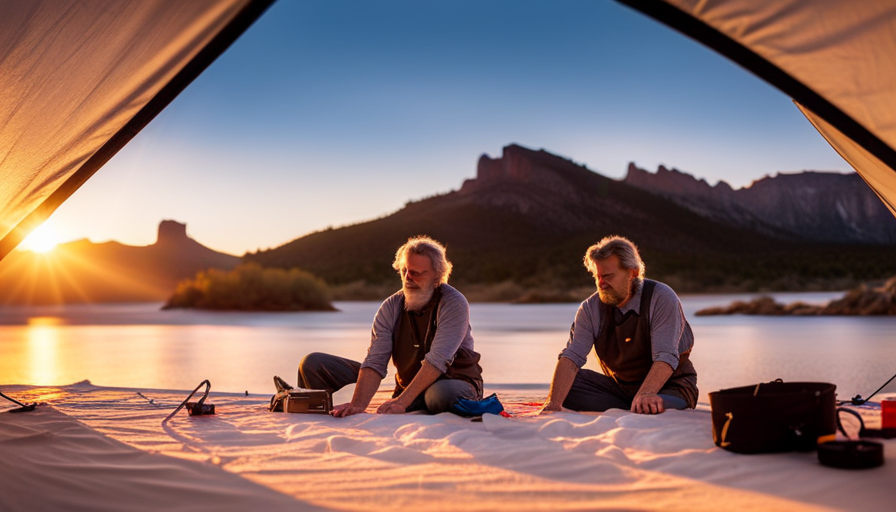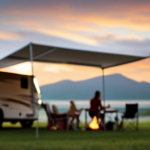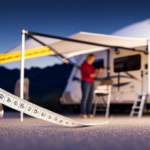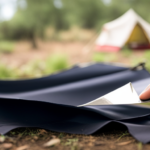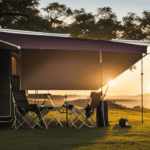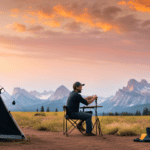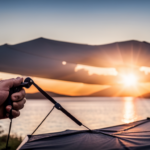Are you ready to enhance your pop-up camper adventures? Stay tuned, as I am here to help you create your own pop-up camper awning! With just a few supplies and some sewing skills, you can create the perfect shelter for shade and protection during all your outdoor excursions.
Picture this: you’re sitting under your homemade awning, sipping a cold drink, and enjoying the great outdoors without a care in the world. Sounds pretty amazing, right? Well, it’s time to turn that daydream into a reality.
In this article, I’ll guide you through each step of the process, from measuring and cutting the fabric to attaching grommets and installing awning rails on your camper. I’ll even give you some tips on how to test and adjust your awning for optimal functionality.
So, grab your tools and let’s get started on creating the ultimate pop-up camper awning that will have your fellow campers green with envy. Trust me, this is a DIY project you won’t want to miss!
Key Takeaways
- Choose durable, waterproof, and UV-resistant fabric for the awning
- Reinforce stress points and consider using waterproof fabric for added durability
- Attach grommets and reinforce edges to prevent tearing and fraying
- Securely attach the awning fabric to the rails for a taut and stable installation
Gather the Materials Needed
Now that you’ve decided to embark on the adventure of making your own pop-up camper awning, it’s time to gather all the materials you’ll need to bring your camping experience to the next level.
The first step is choosing the right fabric. You’ll want to select a fabric that’s durable, waterproof, and UV-resistant. Look for materials like heavy-duty canvas or polyester that can withstand the elements and provide protection from the sun and rain.
Next, you’ll need to find the best grommets for your awning. Grommets are the metal rings that reinforce the holes in the fabric and allow you to attach the awning to the camper. Look for grommets made of brass or stainless steel, as they’re more resistant to rust and corrosion.
Once you have all your materials, you’ll be ready to move on to the next step: measuring and cutting the fabric. This is an important step to ensure that your awning fits properly and provides adequate coverage.
Measure and Cut the Fabric
To begin, I carefully measure and cut the fabric for my homemade awning. Accurate measurements are crucial to ensure that the awning fits properly on my pop-up camper. I use measuring techniques such as using a measuring tape and marking the fabric with chalk to indicate the desired length and width.
It’s important to measure twice and cut once to avoid any mistakes.
For cutting the fabric, I use fabric cutting tools such as fabric scissors or a rotary cutter. These tools allow me to make precise and clean cuts. I make sure to follow the marked lines and cut along them carefully. It’s important to have a steady hand and take my time to ensure that the fabric edges are straight and even.
Once I have measured and cut the fabric panels for my awning, I’m ready to move on to the next step of sewing them together. This will create a sturdy and durable awning that’ll provide shade and protection during my camping adventures.
Sew the Fabric Panels Together
Once the fabric panels are cut, I can begin sewing them together to create a seamless and durable awning. Here are some sewing techniques and fabric selection tips to ensure a successful project:
-
Choose the right thread: Opt for a heavy-duty thread that matches the color of your fabric. This’ll provide extra strength and prevent the thread from easily breaking.
-
Use a straight stitch: When sewing the fabric panels together, use a straight stitch with a medium-length stitch length. This’ll create a secure seam that won’t easily unravel.
-
Reinforce stress points: To ensure the awning can withstand strong winds and tension, reinforce stress points such as the corners and edges. You can do this by sewing multiple rows of stitches or using a zigzag stitch.
-
Consider waterproof fabric: If you plan on camping in rainy conditions, choose waterproof fabric for your awning. This’ll help keep you dry and prevent water from seeping through.
Now that the fabric panels are sewn together, it’s time to move on to the next step: attaching grommets and reinforcing the edges. This’ll provide added stability and ensure the awning stays securely in place.
Attach Grommets and Reinforce Edges
With the fabric panels sewn together, it’s time to add grommets and reinforce the edges for added stability and durability. Grommets are essential for attaching the awning to the camper and preventing the fabric from tearing.
To reinforce the grommets, start by folding over the fabric edge by about 1 inch and sewing a straight stitch along the fold. This’ll create a strong and secure edge for the grommets to be inserted into.
Next, place the grommets evenly along the edge, spacing them about 12 inches apart. Use a grommet kit and follow the instructions to attach the grommets securely to the fabric.
In addition to the grommets, it’s important to reinforce the edges of the awning to prevent fraying and prolong its lifespan. One effective technique is to use binding tape or bias tape to cover the raw edges of the fabric. This’ll provide a clean and finished look while protecting the fabric from wear and tear. Alternatively, you can fold over the edges and sew a straight stitch to create a double-folded hem. This’ll add extra strength and prevent any fraying.
Now that the grommets are in place and the edges are reinforced, we can move on to the next step of the process: installing awning rails on the camper. This’ll allow us to easily attach and detach the awning whenever needed.
Install Awning Rails on the Camper
Now that we’ve reinforced the edges and added grommets, it’s time to install the awning rails onto the camper for easy attachment and detachment. To begin, you’ll need to gather the necessary materials and tools: awning rails, screws, a drill, a measuring tape, and a level. Installing awning brackets is the first step. These brackets will secure the awning rails to the camper. Measure and mark the desired height for the rails, ensuring they will be level. Use a drill to attach the brackets to the camper, making sure they are securely fastened.
Next, choose the right awning fabric for your camper. Consider factors such as durability, water resistance, and UV protection. There are various materials available, such as vinyl, polyester, and acrylic. Choose one that suits your needs and preferences.
Once the awning rails and brackets are installed, you’re ready to attach the awning fabric to the rails. This will be discussed in the subsequent section.
Attach the Awning Fabric to the Rails
To easily attach and detach the awning fabric, simply slide it into the installed rails. There are a few methods you can use to ensure a secure and durable attachment of the awning fabric to the rails:
-
Velcro Straps: One popular method is to sew velcro straps onto the fabric and attach them to corresponding velcro strips that are glued or screwed onto the rails. This allows for easy adjustment and removal of the fabric.
-
Snap Fasteners: Another option is to use snap fasteners. Sew the male and female parts of the snaps onto the fabric and the rails respectively. This provides a strong and secure attachment.
Tips for ensuring a secure and durable attachment of the awning fabric to the rails:
-
Make sure the fabric is aligned properly with the rails before attaching. This will prevent any wrinkles or sagging.
-
Double-check that all attachments are secure and tight. Loose attachments can cause the fabric to flap or come loose in windy conditions.
Now that the awning fabric is securely attached to the rails, the next step is to secure the awning in place to ensure it stays put during your camping adventures.
Secure the Awning in Place
Once the awning fabric is firmly attached, you can ensure its stability by securely fastening it in place. There are several securing methods you can use to keep your pop up camper awning secure during your outdoor adventures. One option is to use awning straps, which are adjustable and can be tightened to keep the fabric taut. Another method is to use bungee cords, which provide flexibility and allow for easy adjustment. Additionally, you can use stakes or anchors to secure the corners of the awning to the ground, preventing it from being blown away by strong winds.
To maintain the awning and extend its lifespan, there are a few maintenance tips to keep in mind. Regularly clean the fabric with mild soap and water to remove any dirt or stains. Make sure to let the fabric dry completely before retracting the awning to prevent mold or mildew growth. It’s also important to inspect the awning for any tears or damages and promptly repair them to prevent further issues.
By securely fastening your pop up camper awning and following these maintenance tips, you can ensure its longevity and enjoy the shade and comfort it provides during your outdoor adventures. In the next section, we will explore how to add accessories for functionality, enhancing your camping experience.
Add Accessories for Functionality
Enhance your camping experience by adding accessories that improve the functionality of your awning. There are a variety of accessory options available, each offering unique benefits that can make your camping trip more enjoyable and convenient.
-
Awning Lights: Adding lights to your awning can create a cozy and inviting atmosphere at night. LED string lights are a popular choice as they’re energy-efficient and provide ample illumination.
-
Awning Screen Room: A screen room attachment can transform your awning into a bug-free zone where you can relax and enjoy the outdoors without worrying about pesky insects. It provides an additional living space and keeps you protected from the elements.
-
Awning Table: A foldable table that attaches to your awning can be a useful addition. It provides a convenient surface for preparing meals, playing games, or simply enjoying a cup of coffee.
By adding these accessories, you can maximize the functionality of your awning and create a comfortable outdoor living space.
Once you’ve added the necessary accessories, the next step is to test and adjust the awning to ensure it’s secure and properly functioning.
Test and Adjust the Awning
After adding the accessories, it’s crucial to ensure that the awning is secure and functioning properly through testing and adjustments. Testing the awning is essential to identify any issues and make necessary adjustments before hitting the road. To test and adjust the awning tension, follow these steps:
- Set up the awning according to the manufacturer’s instructions, making sure it is securely anchored to the camper.
- Extend the awning fully and check for any sagging or unevenness. Adjust the tension by tightening or loosening the support poles or straps.
- Test the awning’s ability to withstand wind by gently shaking it to see if it remains stable. If it wobbles excessively, reinforce the support structure.
- Troubleshoot common awning issues such as difficulty in retracting or extending, loose hardware, or tears in the fabric. Address these problems before hitting the road.
By testing and adjusting the awning, you can ensure that it will function properly during your camping adventures. With a secure and functional awning, you’ll be able to enjoy your homemade pop-up camper awning to the fullest.
Enjoy Your Homemade Pop-Up Camper Awning!
To fully appreciate the benefits of your homemade pop-up camper awning, savor the moments of tranquility and shade it provides during your outdoor adventures. Having an awning can make a huge difference in your camping experience, providing much-needed shade on hot days and protection from the elements during unexpected rain showers. Not only does it enhance your comfort, but it also adds a touch of personalization to your camper setup.
One of the major benefits of using a homemade awning is the cost savings. By making it yourself, you can save a significant amount of money compared to purchasing a pre-made awning. Plus, you have the freedom to customize it to your liking, ensuring that it perfectly fits your camper and meets your specific needs.
To maintain your homemade awning and ensure its longevity, there are a few tips to keep in mind. Firstly, make sure to clean it regularly to remove any dirt or debris that may accumulate. Use a mild soap and water solution and gently scrub the fabric. Additionally, inspect the awning for any signs of wear or damage, such as tears or loose stitching. Repair any issues promptly to prevent further damage.
By following these tips and enjoying the benefits of your homemade pop-up camper awning, you’ll be able to create lasting memories and enjoy countless outdoor adventures in comfort and style.
Frequently Asked Questions
How much does it cost to make a homemade pop-up camper awning?
Making a homemade pop-up camper awning can be a cost-effective alternative to purchasing one. When it comes to cost estimation, it depends on the materials you choose. By opting for alternative materials like PVC pipes and waterproof fabric, you can significantly reduce expenses.
Additionally, considering factors like size, durability, and functionality will help you determine the overall cost. With careful planning and resourcefulness, creating your own awning can provide both savings and satisfaction.
Can I use a different type of fabric for the awning?
When considering different fabric options for a pop-up camper awning, there are a few factors to consider.
One option is using a waterproof fabric, such as polyester or nylon, which can provide protection from rain and UV rays.
Another option is using a breathable fabric like acrylic, which allows for better airflow and can be more comfortable in hot weather.
However, it’s important to consider the weight, durability, and ease of maintenance of each fabric type before making a decision.
How long does it take to sew the fabric panels together?
On average, it takes about 4-6 hours to sew the fabric panels together for a pop-up camper awning. However, the sewing time estimation can vary depending on your sewing skills and the complexity of the design.
To ensure a smooth and efficient sewing process, it’s important to use proper sewing techniques. This includes pinning the fabric panels together before sewing, using a suitable sewing machine, and making sure to sew in straight lines for a neat and professional finish.
Do I need any special tools to attach the grommets and reinforce the edges?
To attach grommets and reinforce edges, you’ll need a few special tools. First, you’ll need a grommet tool kit, which typically includes a hole punch, a setting tool, and a variety of grommets. This will allow you to create the holes and secure the grommets in place.
Additionally, you may want to have a sewing machine with a heavy-duty needle to reinforce the edges of the fabric panels. These tools will ensure a sturdy and durable awning.
Are there any specific safety precautions I should take when installing the awning rails on the camper?
When it comes to installing awning rails on your camper, safety should be your top priority. Before you start, make sure to wear your full-body hazmat suit, complete with helmet and gloves.
Next, hire a team of highly trained professionals to handle the installation, as it requires extreme precision and expertise.
Don’t forget to have a first-aid kit on standby, just in case.
Remember, installing awning rails is not for the faint of heart, so proceed with caution!
Can I Use the Same Mounting Method for a Pop Up Camper Awning as I Would for a TV Mount?
When mounting a magnetic TV mount, the process is quite different from mounting a pop up camper awning. For the TV, it involves finding a suitable metal surface to attach the mount. On the other hand, for the camper awning, the mounting method involves drilling and securing the awning to the camper.
Conclusion
In conclusion, making your own pop-up camper awning is a rewarding and practical project that can enhance your camping experience. By following the steps outlined in this article, you can create a custom awning that fits your needs and style.
Remember, Rome wasn’t built in a day, so take your time and ensure each step is done correctly. Once you’re finished, you’ll have an awning that’s as snug as a bug in a rug, ready to provide shade and protection on your camping adventures. Happy camping!

